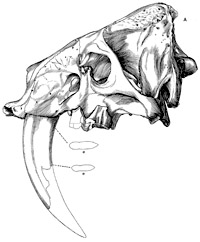Museum, University of Nebraska State
Date of this Version
7-1972
Document Type
Article
Citation
BULLETIN OF THE UNIVERSITY OF NEBRASKA STATE MUSEUM, VOLUME 9, NUMBER 8 JULY, 1972, Pp. 205-213, Tables 1-3 Frontispiece, Figs. 1-4
Abstract
Further study indicates that the Menoceras remains collected from the "Bridgeport Quarries" (lower port:on or the Marsland Formation, Middle Miocene, of the Hemingford Group) are of a new species.
In 1962, these dicerathere remains were considered to be a geologic variety of Diceratherium niobrarensis (Stecher, Schultz, and Tanner). However, later (Tanner, 1969) a generic distinction was revived, separating the Menoceras Troxell from Diceratherium Marsh. Diceretherium niobrarensis was then placed in synonymy with Menoceras arikarense (Barbour).
The new species is an intermediate between Menoceras arikarense (Barbour) from the Harrison Formation and Menoceras marslandensis Tanner, from the upper portion of the Marsland Formation.
This study was made using a large collection of rhinoceros remains from sediments considered to be near the base of the Marsland Formation of the Hemingfordian Group (Stecher, Schultz, and Tanner, 1962, p. 101) of northwestern Nebraska. The rhinoceros skeletal parts are from quarries which have been previously recorded as the "Bridgeport Quarries." (See Schultz and Stout, 1941, pp. 20, 27, and 43.) These U.N.S.M.2 collecting localities are located 8½ to 9½ miles north of Bridgeport, Nebraska, and have been assigned the following collecting locality numbers: Mo-113, Mo-114, Mo-115, Mo-116, and Mo-118 (Schultz and Stout, 1961, p. 8, Fig. 3; Stecher, Schultz, and Tanner, 1962, p. 101; and Tanner, 1969, p. 401 ). These quarries have yielded the Menoceras skeletal remains considered in this paper; however, most of the specimens are recorded as being collected from U.N.S.M. Coll. Loe. Mo-113 and Mo-114. These quarries were first discovered in 1932 and were subsequently worked for several years (Stecher, Schultz, and Tanner, 1962, p. 101). A very large rhinoceros collection was assemb!ed for the University of Nebraska State Museum. The Menoceras, which constitutes the major genus in this collection, is considered specifically different from other diceratheres of the Miocene (Tanner, 1969).
As a part of the revision of the phylogenetic scheme for Diceratherium and Menoceras, a chart showing the two lineages was prepared by Tanner (1969, Fig. 1). At that time (p. 402) it was indicated that an exact specific allocation for Menoceras, from the "Bridgeport Quarries," was uncertain. However, further study of these fossil rhinoceros remains from the lower portion of the Hemingford Group presents evidence which justifies the naming of a new species.
Included in
Entomology Commons, Geology Commons, Geomorphology Commons, Other Ecology and Evolutionary Biology Commons, Paleobiology Commons, Paleontology Commons, Sedimentology Commons


Comments
Copyright 1972 University of Nebraska